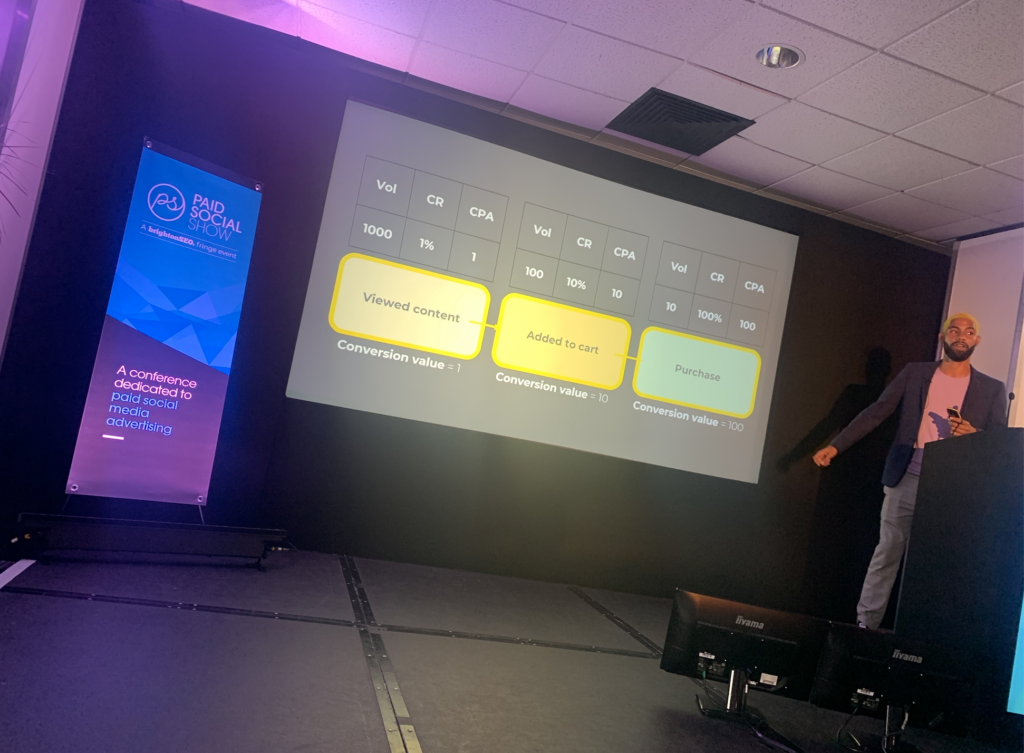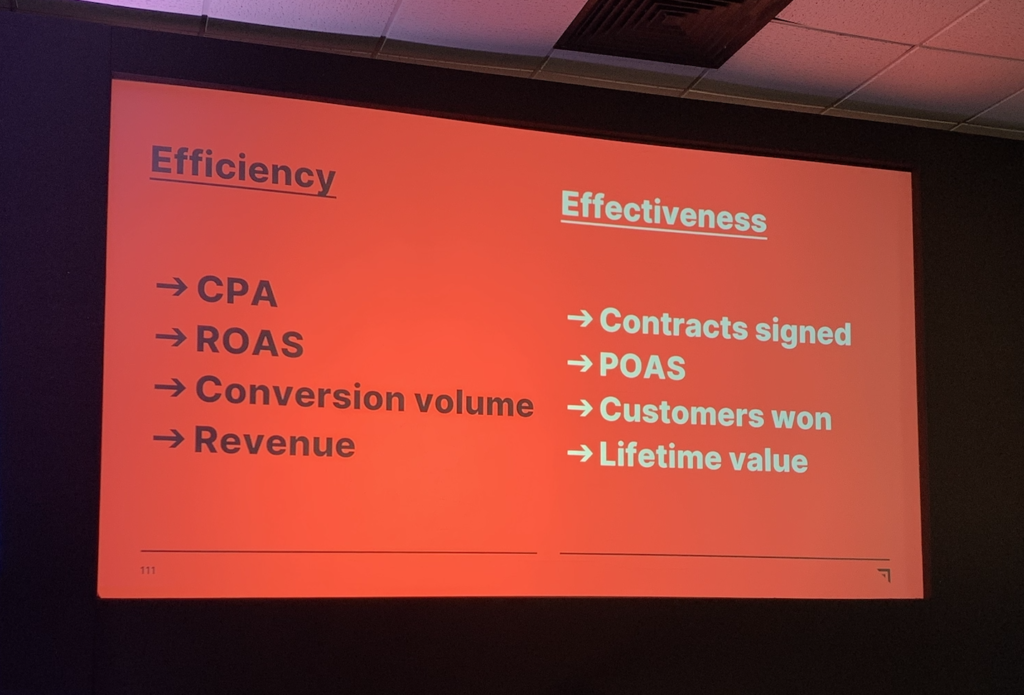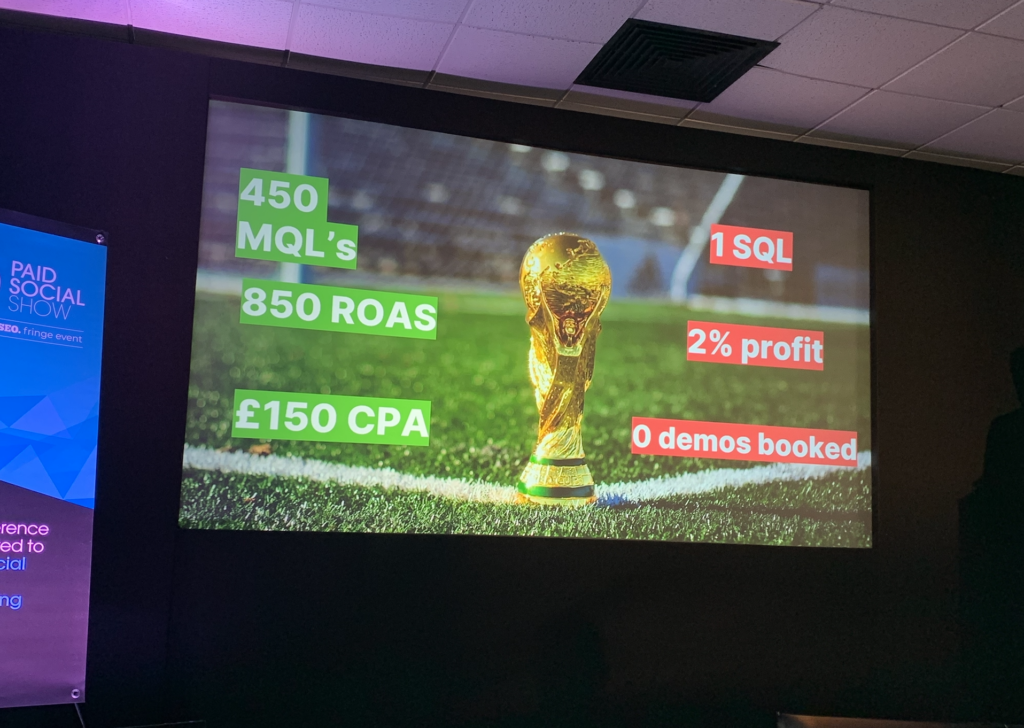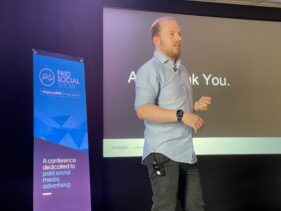A spin off event from brightonSEO, the Paid Social Show helps delegates to learn how to promote their business and clients through Facebook, Instagram, Twitter, LinkedIn and other social media platforms and the wealth of advertising options available in each one.
Day 1 – the highlights
Paid social media advertising is one of the most exciting and fastest changing areas of digital marketing, with new platforms and opportunities within them emerging at a scintillating pace.
Our team, with our very own Josh Crawford taking to the stage, immersed themselves in the very latest and greatest in their professional landscape. Here are the highlights from day one.
10am – 11am
Nadya Birca – Why short-form video rules: The difference between reels, shorts and TikTok
Why are shorts getting bigger?
People are lazy. OK, maybe not lazy but time poor. Throw in a short attention span and a saturation of content and all of a sudden, short form video rules.
It started with the ice bucket challenge, and has evolved into a dominant force across social platforms and search. Insta reels, YouTube shorts and now Pinterest pins are instant means of short form gratification that satisfy an evolving market, with YouTube leading the way in monetising short form.
But what content creators need to ask themselves, in this space is, how do I stop people scrolling? With the impending land of the Metaverse promising immersive experiences, short form video will no doubt need to take even bigger leaps into stimulating the mind and providing an innovative and satisfying escape.
Gen Z like to keep it real, which is why unpolished and experiential videos on TikTok take favour. Key takeaways? Keep it simple, not perfect – conveying an authentic message in paid and organic means of delivery, and use your data to improve engagement analysis.
Rebecca Holloway – Why thought leadership MUST be part of your LinkedIn strategy
Love this – dividing your company Thought Leadership into quadrants of specialists: Industry, Service, People and Brand.
#BrightonSEO #PaidSocialShow session by @beccasocial3 pic.twitter.com/mdyCC2g7Et
— James Bavington (@bavington) October 5, 2022
You can’t become a thought leader overnight. In fact, those who try, fail. Why? Because thought leadership requires consistency, brand engagement built from the ground up (starting with your employees) and founded on purpose and brand reputation.
Before you launch into a thought leadership strategy, first consider how strong your foundations are and why you are doing it.
One core focus and strong output of thought leadership is showcasing your employee knowledge, making a big impact for recruitment, which could prove vital in a competitive landscape. Thought leadership built on employee expertise places them front and centre of your business. Perfect for a LinkedIn campaign.
There are four types of thought leadership people can leverage on LinkedIn:
- Industry: add a unique perspective on news and trends
- Service: teach people best practices, FAQs, case studies, good for production teams
- People: Career advice, leadership in business, talent advice, wellbeing, personal growth
- Brand: company culture, values, trends and innovations, case studies.
Your next challenge is to identify who in your business is a suitable advocate for each of these categories. This is our rough guide:
- Industry: All
- Brand: directors, production
- Service: Search and content, production
- People: Search and content, directors, production
One of the first key steps to advocating these elements and building a brand foundation on LinkedIn to deliver thought leadership is to encourage your whole team to deliver short form content. these tidbits give a flavour of your collective and individual values and can spark conversation around key topics you may wish to drive the conversation in.
Once you have identified your core target audience and the topics of value to you, building your thought leadership stance becomes more simple, particularly if you can find a niche or stance that proves unusual or provocative. Be brave, but be strategic and don’t launch in without galvanising your team.
Neha Divanji – Create paid social marketing plans to mirror your customer journeys
How do we increase buy in and engagement over a short period of time?
Frictionless customer experiences are key – driven by strong and specific segmentation.
Smol does an amazing job of segmenting their market and delivering extremely well targeted and personalised messages to their defined audience. From ad formats through to landing pages, their messaging is on point because they are well informed and attentive to customer needs at different phases of the purchase journey.
At each stage:
- Create personas for target customers
- Identify the value proposition identified on each persona/segment
- Map the customer journey to your funnel and targeting strategy
Nuuud leveraged their Dragons’ Den appearance across the journey to drive interest and awareness, but also advocate quality and create trust signals. Implementing a competition in the consideration phase was a genius means of creating brand loyalty early on in the purchase process, increasing the chances of purchase.
Raindrop Pensions take a slightly different approach by using their value proposition to encourage purchase, whilst lacing social causes into the customer journey to convey their business values. By evoking emotion they drive down the lead to purchase time by moving from awareness to consideration seamlessly.
In short, brands now need to adopt the right and most meaningful way of engaging customers across the purchase journey quickly, succinctly and strategically. This means understanding their customer needs, mapping their customer journey and delivering campaigns and content that move them through the process whilst staying true and relevant to value propositions and brand values.
11:30 – 12:30
Josh Crawford, StrategiQ – Levelling up paid social with Google Sheets
Check out Josh’s Deck here
Here's the deck with all of the formulas from @joshcravvford's session 'Levelling up paid social with Google Sheets'https://t.co/3MQfHFFM1Y#BrightonSEO #PaidSocialShow @StrategiQ pic.twitter.com/5Chtq3DyLa
— James Bavington (@bavington) October 5, 2022
Karl Sykes-Tobin – How to leverage machine learning with paid social
It’s time to get really smart about leveraging machine learning – and that doesn’t mean outsmarting AI, but knowing when to relinquish control in favour of algorithms driven by data and knowing when to simply go with your gut.
Is there a way to fight against the machines? How can we trick the system? When do we need more control and when is it a case of simplifying what we have control over.
It starts with data, and that data is changing the way we manage paid social, which used to be ‘how targeted can we segment audiences with as much detail as possible?’ And is now ‘how do we use data and complex business goals in order to allow the systems freedom to work harder for us?’
But what happens when you don’t have enough data? The speaker recommends using clustering, in the absence of enough data to create lookalike audiences, driving a segment combining actions from higher up the funnel (which on their own don’t offer enough detail and intent) with other components including ‘add to cart’, scroll depth, time on site, viewed content. These elements build a picture of (as close to) your perfect target, using machine learning to deliver with the human input of weighting metrics in your cluster to adapt the process to your brand’s needs.
This session provoked a lot of discussion and opinion about a lack of evidence on the pros and cons of machine learning, which is continuing to evolve from its infancy in the space. Perhaps the picture and big debate about the need for a weighting of machine learning will become more cut and dry as we have more case studies and proven or disproven applications of it.

Jack Brown – CPA & ROAS are dead: long live lifetime value
It’s a bold statement in paid media land. But it is one worth making based on the increasing need to acknowledge lifetime value metrics in determining the ROI of your campaign.
Why? Because metrics further down the funnel are simply more effective. Cost per acquisition (CPA) and return on ad spend (ROAS) are an efficient means of measuring current campaign performance, but only provide a snapshot of the impact of the campaign on revenue in the longer term.
Paid media specialists can rely on ROAS and CPA as an efficient means of delivering a quick overview but what is the real ROI of that campaign where contracts, partnerships and referrals come into play?
We are in a hiatus, whereby we need to feed more data into machine learning to deliver more complex but sophisticated means of assessing ad performance.
So how can we do it?
Firstly we can make manual calculations, implement averages and then generate automated reports. Conversion rates through the funnel with an attributed value will also build a more complex but accurate picture of campaign impact. We can also target campaigns and individual landing pages – then set the different values depending on expected order value. Ensure offline conversion data is fed through the Conversions API – when a deal is triggered in a CRM for that data to be delivered to Facebook.

But most importantly, always optimise for metrics that grow the business.

14:00 – 15:00
Sarah Sal – Creating content as irresistible as ice cream on a hot day
When it comes to content that sells, solves a problem or creates a vision, quality over quantity is key. Even better? If you can personalise communications to evoke an emotion from the person that you are contacting with that content.
If you’re looking to deliver really tantalising content, and we’re guessing that you are, pick a fight and push the boundaries., and definitely don’t blend in with what everyone else is creating. If you can be controversial and bold, you’ll be more likely to stimulate virality.
And most importantly, be unique as you represent your brand by choosing a topic or a theme and a stance that is truly different, because only then can you guarantee you’ll resonate with that audience in a way no one else has before.
Diana Andreea Mereoiu – Getting to the point: paid social strategy for explanation intensive B2B products
The B2B space is more complex than ever, with longer lead times, more decision makers, decision by committee (often) and a lagging and fatigued advertising space.
Long lead times mean advertisers need to be smart at targeting people at the cited 7 stages of research that go into making the average B2B decision, which means attribution is also really tricky. However, there are ways and means of using advanced techniques that can help combat longer lead times, including feedback forms, comments sections on Facebook and direct messages as a means of attributing ROI.
In the B2B space, 59% of decision making processes have 4+ members. Which means we need to tap into each of those decision makers with information and solutions relevant to them. For example, a Chief Financial Officer may need more finance data, or a Chief Marketing Officer may want to understand the ROI on a service. Which means it pays to not talk about the product but the solution.
Factors that vendors are evaluated against come down to pricing, 82% of the time and reviews 52% of the time, which means your price point and your social proof are both of high importance, so even if your offering is more expensive, if you can demonstrate the value that it provides that business or individual, you are more likely to win. Essentially sales is not about you and your product, it is about how you solve a problem.
Knowledge sharing is far more effective than the dreaded gated content. Gated content is truly a frustration and becomes an immediate barrier at any of the 7 stages of decision making. If your content is available, free and imparts wisdom, you are more likely to generate a lead.
The key takeaways from this session is to redesign testing and focus on attribution to refine your approach to B2B marketing, who knows, we would reignite the space and shorten lead times with a targeted but well considered customer-first approach.
15:30 – 16:30
Rachel Fellows: TikTok advertising
Why TikTok? The stats are scary. It’s the #1 downloaded app in the US (apparently), with an average 19 opens per day. Unsurprisingly kids aged under 18 are the biggest users, spending around 75 minutes per day on the platform.
TikTok’s success is down to how addictive it is. Our brains want dopamine hits. Watching videos you enjoy stimulates the happiness chemical. So we continue to scroll till we get another hit. The ‘high’ of a hit is likened to the dopamine we get from gambling.
Of course, the TikTok algorithm is designed to keep you scrolling. Its simplicity reduces the load on our brains. Whereas FB on the other hand has multiple content types and uncertainties.
Interested in advertising on TikTok? Things to check include:
Audience
Is your audience there? TikTok’s targeting options are limited, with country level targeting only. The ability to target around interests are limited and restricted. However you can upload segmented customer data to improve targeting.
Resource
Do you have the resources to create creative videos?
7 days is the decay timeline for a piece of creative
TikTok is built for sound on – FB 12% have sound TikTok in the 80s. e.g. Fleetwood Mac. Sounds can go viral
Goals
Does TikTok align with your business goals? Having a presence lends to brand awareness, but can be good for lead gen too. Think entertainment first, messaging second – Duolingo is a best in class example.
Top Tips for advertising with TikTok
- Creative is king ( but change it up, attention is small and differentiation is key).
- Get your message out within the first 3 seconds
- Be authentic
- Use lookalikes
- Don’t sweat the comments (monitor, but don’t fear)
- Target. Target. Target.
Becky Dickinson: Meta schmeta – auditing your Facebook ads
There are four clear steps to auditing your Facebook ads:
- Tracking
- Strategy & bidding
- Audiences
- Creative
1. Tracking and data
“Without data you are just another person with an opinion” – and bad data means bad decisions, which is why it may be more effective and accurate to use the Conversions API than Facebook Pixels, which are rapidly becoming less accurate due to their reliance on cookies and other questionable tech. By checking the quality of the conversions API using the events manager, and checking data frequently, you can feel more confident about the quality of your most valuable asset.
2. Structure & Bidding
When auditing your structure and bidding, make sure you consider the objectives. Also consider the Facebook learning phases and where users are in the funnel. But remember – the Facebook Learning phase needs 50 events in 7 days and long lead cycles will impact this, so micro conversions will need to be used in these instances.
As with all auditing, test and learn – it’s not a one size fits all approach, which has been a key theme for all of the day at the Paid Social Show. We don’t know what works best until we actually start running ads.
3. Audiences
Sometimes, broader can be better – we can uncover audiences that wouldn’t naturally be exposed to. Don’t forget to make use of the Insights tools – in which auction competition will highlight reasons for changes to cost per click (CPC)
Watch out for audience overlap, cannibalising campaigns and burning through budget, decreasing ROI.
4. Creative
“Creative without strategy is art. Creative with strategy is advertising” – controversial comment of the day, because there have been some incredibly creative ads over the years which are an absolute art.
Creative is responsible for the largest contribution to sales, at 47%, and a good creative increases the total value of an ad. However, if the bidding strategy doesn’t match the creative input, a poor creative could be out displayed by a lower bidding incredible creative.
And remember – Facebook is not a source of truth. It is imperative to. review overall marketing efforts and where Facebook plays in that bigger picture.
Kitty Newman: Reaching decision makers through LinkedIn advertising – a case study
With 830M users, LinkedIn offers huge potential, but also a lot of competition. To grow your brand on the platform, marketers need to be clever. It’s not a quick fix, or an easy ride. But it can be done. In a recent case study, we connected with 66% of targets, and got a 40% response rate. Overall, 100% of outbound was initiated on LinkedIn. Here’s some takeaways:
Target: take a structured approach to finding your dream targets. Build out a spreadsheet of key companies and stakeholders, and share this across the business so that everyone is on the same page.
Connect with your targets, and then message them quickly – ideally within 24 hours as this is proven to increase the likelihood of a conversation by 60%.
Personalise your content: yes it’s fine to have a tested introduction but put a personal spin on it.
Have a great offer. Content and creativity is your secret weapon. Your client has 99 problems – which one are you solving? Is it faster delivery, a home meal kit, a thought leadership piece? Be smart about your content. One whitepaper or blog can be sliced many ways.
Boost company posts to target prospects – this will increase trust and help stay front of mind. This helps build trust, awareness and social proofing.
Be social. LinkedIn is great for maintaining connections and building relationships. Be social, be communicative, and know who you’re talking to. Don’t forget to work on your personal brand too – this should reflect well with your company’s.
And that’s a wrap! We’ll be back with our coverage of Paid Social Show – brightonSEO – Day 2 tomorrow!
Psst: fancy joining this bunch of ambitious creatives and attending cool events like this? Take a look at our Vacancies.


















